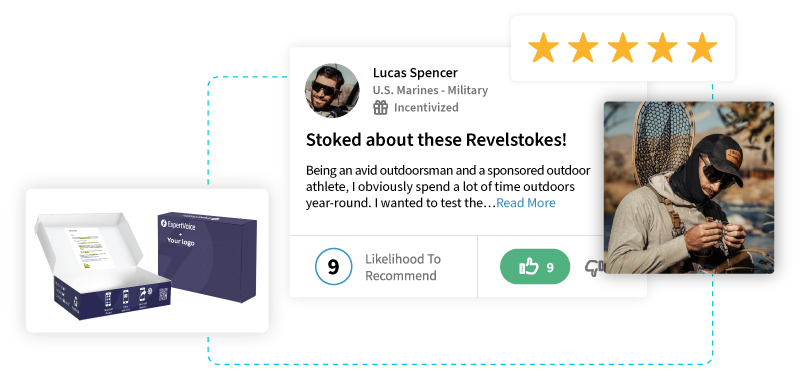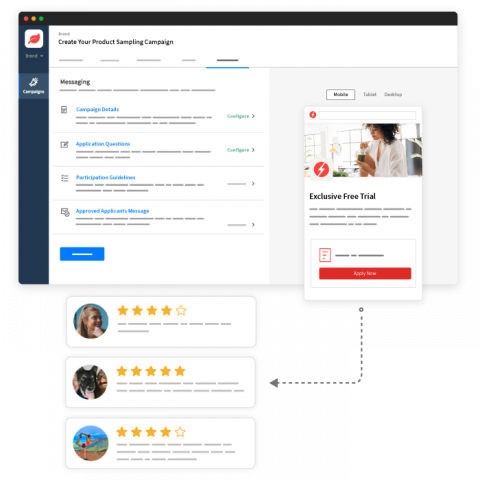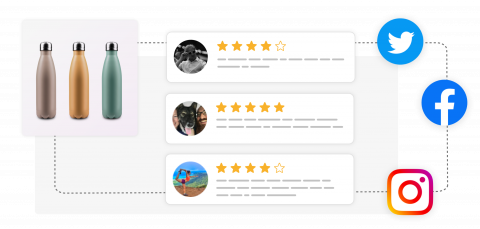Mastering product sampling: A comprehensive how-to guide

To lots of us, sampling brings the aisles of Costo to mind (and yes, apparently, they do notice us coming back for seconds). Giving out free products in the hopes that a customer will return to buy, subscribe or become a brand loyalist. But sampling can be so much more than that for brands.
Product sampling stands as one of the most reliable and practical strategies to connect with your audience, deliver tangible value and collect authentic customer feedback that will convert. And it’s making a comeback. Let’s explore the when, why and how of all things sampling.
Jump in:
What is product sampling?
At its core, product sampling is the art of providing customers with a taste, touch, or trial experience of your offerings. It’s a tangible way to introduce them to your brand, allowing them to experience your products firsthand.
But that’s not the only use case for product sampling; it’s also a fast, simple and effective way for brands to generate ratings, reviews and other user-generated content (UGC) that drives e-commerce performance and converts customers.

Does product sampling work?
Short answer: absolutely. Product sampling isn’t just a shot in the dark; it’s a proven strategy backed by compelling statistics, especially since consumers rely on social proof to make buying decisions now more than ever. The biggest benefits of product sampling include:
Build relationships and collect product feedback
We all love a free sample, but we love feeling valued even more. Make your target customer base and brand loyalists feel like an extension of your brand — because, at the end of the day, they kind of are. By bringing customers, new or old, into the fold, you can collect invaluable product feedback and make those individuals part of your development process. Achieveing two things: converting that group of important consumers into lifelong fans and collecting essential feedback from the people whose opinions matter most as you develop the best possible product.
Enhance your social media
Customers love seeing themselves reflected in your brand. And 93% of marketers agree that consumers trust content created by customers more than content created by brands. Product sampling is a simple way to collect significant amounts of UGC (user-generated content) to populate your social media presence.

Collect trustworthy reviews
Since 88% of customers trust reviews from fellow consumers as much as personal recommendations, it’s important to collect reviews that people can and should trust. Because sampling allows you to pick participants, you’ll be able to ensure that the people trying out your product know their stuff. Tap into tailored audiences who know their stuff to put your products to the test and provide genuine reviews.
Plus, there’s a sense of reciprocity. Meaning people who receive a free sample from a brand are more likely to do something positive in exchange, such as sharing a positive review. This doesn’t mean every review is going to be glowing, nor should it. In fact, even a few negative or neutral reviews can build consumers’ confidence in your brand’s authenticity.
Boost sales and conversion rates
You’ve heard us say it before — authentic product reviews are everything these days. 51% of consumers trust UGC more than other information on a brand’s website. Product sampling is an effective way to generate UGC, such as reviews and testimonials, which can significantly influence purchasing decisions across social and e-commerce selling channels. channels.
Types of product sampling?
There are tons of tactics to sample your products, each with its own pros and cons, but here are a few of the basic strategies.
1. Traditional in-store sampling:
Here’s where your classic Costco freebie comes in. This allows people to experience the product’s quality firsthand, potentially leading to future purchases and loyal customers.
2. Direct-mail sampling:
Another popular product sampling strategy. Companies can send samples of their product directly to customers through the mail. It can be a cost-effective tactic for brands that want to target specific demographics.

3. For sale samples:
Near the checkout registers at various retail locations, brands often offer smaller-sized samples of their product to drive trial at a lower price point. This tactic also works well on e-commerce sites through personalized suggested up-sells.
4. Influencer gifting:
A strategy that’s clearly gained traction in recent years. Brands collaborate with influential individuals in their market and gift them products, typically via direct-mail or at in-person events. Influencer sampling allows companies to leverage the trust and authority that influencers have built with their followers.
5. Sample and subscription boxes:
Sample boxes are either free for the receiver, come with a one-time fee or require a monthly subscription. Shipments usually have customized packaging, an “Instagrammable unboxing moment” and a personal thank-you note with recommended next steps. Paid subscription boxes with mystery bundles of product samples originated around 2010 and continue to evolve as shoppers’ preferences change.
When is the right time to launch a product sampling campaign?
Again, this depends on your brand and goals — here are a couple of good opportunities to leverage sampling.
During the product development phase
It’s common for brands to gather feedback from regular people. Yet increasingly, brands are learning that getting their customers involved is effective for both community-building and making crucial brand development decisions. Not to mention a cost-effective tactic to collect key user-testing, and market research.
Running a product sampling campaign often accomplishes two objectives at once. Even if your initial aim wasn’t solely focused on gathering product feedback and identifying development opportunities, you might find yourself gaining valuable insights. For instance, Nicholas Sells, a Digital Specialist at Edge Eyewear, shared his experience, “We collected comprehensive reviews that provided a really in-depth analysis of our products, which is also super valuable from an internal perspective for our product development team.”
When you’re launching a new product
Probably the most obvious use case for sampling is when you’re introducing a new product or line into the world. We know reviews are central to driving sales, 8 out of 10 millennials will never buy anything without reading a review first, so how do you generate those first reviews that’ll give future shoppers the confidence they need to buy?
Sampling is a great way to ensure that as soon as the product detail page goes live, you’ll have plenty of reviews already available to provide prospective buyers with social proof. A great example of this comes from Edge Eyewear, a brand that embodies both style and safety. While launching new line, they turned to product sampling, sending free sunglasses to a hand picked group of industry experts resulting in hundreds of product reviews and customer images — a foundational amount of testimonials to back their new line.
If you need to fill content gaps and generate reviews fast
For products with a sparse review section or seasonal product pushes that need reviews quickly, sampling is a great strategy.
Take NFS Sports for example — a sports nutrition brand looking for a way to boost awareness of their supplements among industry pros. Their team leveraged product sampling to collect reviews at scale and display them across their e-commerce site resulting in a 76% lift in conversion rates and an average 5-star rating.

When it’s time to reach new audiences
If there’s a particular audience that you want to get buy-in on your products, sampling is a great way to start. If you’re breaking into an all-new market or just trying to gain a bit more traction with a particular influential group sampling can be an effective way to target specific demographics.
Cusa Tea and Coffee did just that, in an effort to reach new audiences and increase brand awareness with retail sales associates and industry pros they a sampling campaign even though none of the samplers had ever tried out their products before the trial resulted in repurchase intent along with a huge influx (539% MoM lift) of authentic consumer reviews and product feedback.

That’s the scoop on sampling, time to get started
In a world where consumer skepticism is on the rise, marketing tactics like sampling are essential for building trust and collecting social proof that converts. Many brands are embracing product sampling to make key customers feel like part of their team, jumpstart product development and market their products with compelling firsthand testimonials. Learn more about ways to step into a sampler’s shoes and ensure you’re providing the best possible experience.
Regardless of your objective, product sampling is a powerful marketing tool. It allows you to create genuine connections with your audience, gather valuable insights and boost your brand’s credibility.
Get a sample of sampling on ExpertVoice.
Related Content
The key to simple and effective product sampling
Getting more of the right people talking about your brand is easier than ever. Still, the marketer’s to-do list can be overwhelming. Pair that with the “should-do” list, and it quickly becomes unmanageable. Product sampling shouldn’t be one of those activities that weighs down your team. Typical approaches to product sampling Product sampling isn’t a […]
Read MoreHow product sampling strengthens relationships with online communities
Community-based sampling activates a group of influential consumers and boosts UGC collection. Note: Access to Product Sampling Campaigns and Communities varies based on your Advocacy Platform subscription. Now more than ever, people crave safe places to learn new things, seek inspiration and build genuine connections. Online groups, hosted on social media platforms or through brand […]
Read MoreHow to collect reviews and photos from authentic everyday influencers.
How to collect reviews and photos from authentic everyday influencers. Advocacy MarketingInfluencer MarketingUser Generated Content (UGC) By Product Sampling Campaigns allow you to hand-select samplers to trial free products and share their honest feedback. Note: Access to Product Sampling Campaigns varies based on your Advocacy Platform subscription. Sending out free products to influencers can be […]
Read More




